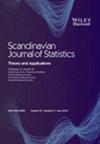生成式对抗网络和其他最小问题的统计推理
IF 1
4区 数学
Q3 STATISTICS & PROBABILITY
引用次数: 0
摘要
本文从统计推断的角度研究生成对抗网络(GAN)。生成式对抗网络(GAN)是一种流行的机器学习方法,通过估算生成器和判别器这两个神经网络的参数来解决一个特定的最小问题。这个最小问题通常有多种解决方案,本文的重点是这些解决方案的统计特性。我们探讨了生成器和判别器网络参数的两个关键统计问题:一致估计和置信集。我们首先证明,样本 GAN 问题的解集是相应群体 GAN 问题解集的(豪斯多夫)一致性估计。然后,我们设计了一种计算密集型程序来形成置信集,并证明这些置信集包含具有所需覆盖概率的群体 GAN 解。小型数值实验和蒙特卡罗研究说明了我们的结果,并验证了我们的理论发现。我们还证明,我们的结果适用于一般的最小问题,这些问题可能是非凸、非凹和多解的。本文章由计算机程序翻译,如有差异,请以英文原文为准。
Statistical inference for generative adversarial networks and other minimax problems
This paper studies generative adversarial networks (GANs) from the perspective of statistical inference. A GAN is a popular machine learning method in which the parameters of two neural networks, a generator and a discriminator, are estimated to solve a particular minimax problem. This minimax problem typically has a multitude of solutions and the focus of this paper are the statistical properties of these solutions. We address two key statistical issues for the generator and discriminator network parameters, consistent estimation and confidence sets. We first show that the set of solutions to the sample GAN problem is a (Hausdorff) consistent estimator of the set of solutions to the corresponding population GAN problem. We then devise a computationally intensive procedure to form confidence sets and show that these sets contain the population GAN solutions with the desired coverage probability. Small numerical experiments and a Monte Carlo study illustrate our results and verify our theoretical findings. We also show that our results apply in general minimax problems that may be nonconvex, nonconcave, and have multiple solutions.
求助全文
通过发布文献求助,成功后即可免费获取论文全文。
去求助
来源期刊

Scandinavian Journal of Statistics
数学-统计学与概率论
CiteScore
1.80
自引率
0.00%
发文量
61
审稿时长
6-12 weeks
期刊介绍:
The Scandinavian Journal of Statistics is internationally recognised as one of the leading statistical journals in the world. It was founded in 1974 by four Scandinavian statistical societies. Today more than eighty per cent of the manuscripts are submitted from outside Scandinavia.
It is an international journal devoted to reporting significant and innovative original contributions to statistical methodology, both theory and applications.
The journal specializes in statistical modelling showing particular appreciation of the underlying substantive research problems.
The emergence of specialized methods for analysing longitudinal and spatial data is just one example of an area of important methodological development in which the Scandinavian Journal of Statistics has a particular niche.
 求助内容:
求助内容: 应助结果提醒方式:
应助结果提醒方式:


